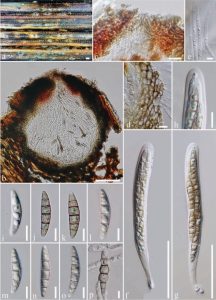Equiseticola fusispora K Abdelsalam, Tibpromma, Wanasinghe & K.D. Hyde, sp. nov., Index Fungorum number: IF 551563
Etymology: The specific epithet fusispora refers to fusoid ascospores.
Saprobic on decaying stem of Equisetum sp. (Equisetaceae). Sexual morph: Ascomata 230–250 μm high, 200–215 μm diam. (x̅ = 239 × 208 μm, n = 5), scattered, solitary, immersed to semi-immersed, uniloculate, ovoid, ostiolate. Ostiole central with minute papilla. Peridium 10–18 μm wide, composed of 3–6 layers, of brown to dark brown cells, arranged in a textura angularis. Hamathecium of dense, 1–2 μm wide, filamentous, septate cellular, pseudoparaphyses, anastomosing bove the asci. Asci 55–90 × 4–9 μm (x̅ = 70 × 8 μm, n = 20), 8-spored, bitunicate, fissitunicate, cylindrical, with long acute or knob-like pedicel, apically rounded, ith well-developed ocular chamber. Ascospores 16–20 × 3–5 μm (x̅ = 17 × 4 μm, n = 20), overlapping 1–2-seriate, initially hyaline, becoming yellowish pale brown at maturity, fusiform with rounded ends, 4–5-septate, usually 5-septate, distinctly septate, with distinct guttules in each cell, not constricted at the septa, smooth-walled, without mucilaginous sheath. Asexual morph: Undetermined.
Culture characteristics: Colonies on MEA reaching 2.5 cm diam. in 2 weeks at 16 °C, white to grey in the center, with circular edge, reverse grey to dark grey, flat on the surface, without aerial mycelium. Hyphae septate branched, hyaline, thin.
Material examined: ITALY, Province of Forli-Cesena, Strada San Zeno, on Equisetum sp., 5 February 2014, Erio Camporesi, IT1701 (MFLU 14-0702, holotype; HKAS94574, isotype); ex-type living culture, MFLUCC 14-0522.
Notes: Our collection of Equiseticola fusispora, is related to Ophiosphaerella agrostidis (MFLUCC 11-0152 & MFLUCC 12-0007) and O. aquatica (MFLUCC 11-0033) in Phaeosphaeriaceae with high support (99% ML, 96% MP and 1.00 BYPP). Ophiosphaerella and Equiseticola are morphologically distinct, Equiseticola has thin peridium, long acute or knob-like pedicel, with well-developed ocular chamber and fusiform, 5-septate ascospores, whereas Ophiosphaerella has a thick peridium, short pedicellate asci, with an indistinct ocular chamber and fasciculate multi-septate ascospores. Phaeosphaeria arenaria, P. epicalamia, P. huronensis, P. luctuosa, P. nofolcia, P. recessa and P. saronica also have 5-septate, fusiform ascospores (Shoemaker & Babcock 1984), that are similar to Equiseticola fusispora, but their relationship cannot be verified as no sequence data are available for comparison. Equiseticola is morphologically resembles with Nodulosphaeria in ascomata characters, peridium structures, cylindrical to cylindric-clavate asci and fusiform ascospores. However Nodulosphaeria is different from Equiseticola in having external or internal periphyses-like setae in ostiole, a swollen upper cell in ascospores with terminal appendages, while Equiseticola has an ostiole without setae, and ascospores without swollen cells or terminal appendages. Thus we introduce a new genus Equiseticola to accommodate our taxon based on unique morphological characteristics together with phylogenetic data. Sequence analyses of rDNA resulted in 13.68 % of parsimony-informative characters (quite low) and therefore it is advisable to consider or evaluate the utility of several other protein genes such as DNA-directed ribosomal polymerase II (RPB2) or translation elongation factor alpha 1 (tef1) to investigate phylogeny among this group of fungi.
FIG 2. Equiseticola fusispora (MFLU 14-0702, holotype) a Appearance of fungus on host surface. b Cross section of ascoma. c Close up of ostiole. d Section of peridium. e Pseudoparaphyses. f–g Asci. h Ocular chamber. i–o Ascospores. p Germinating ascospore. Scale bars: a = 200 μm, b = 50 μm, c = 20 μm, d, h–p = 5 μm, e = 2 μm, f–g = 20 μm.

